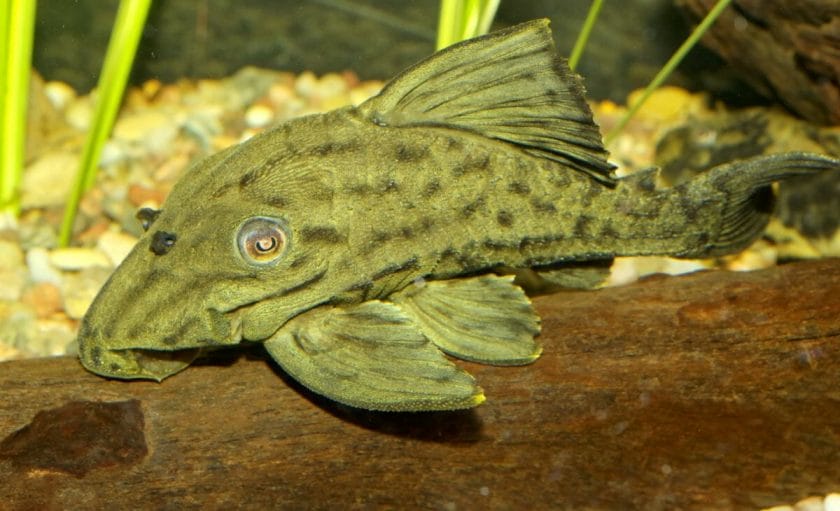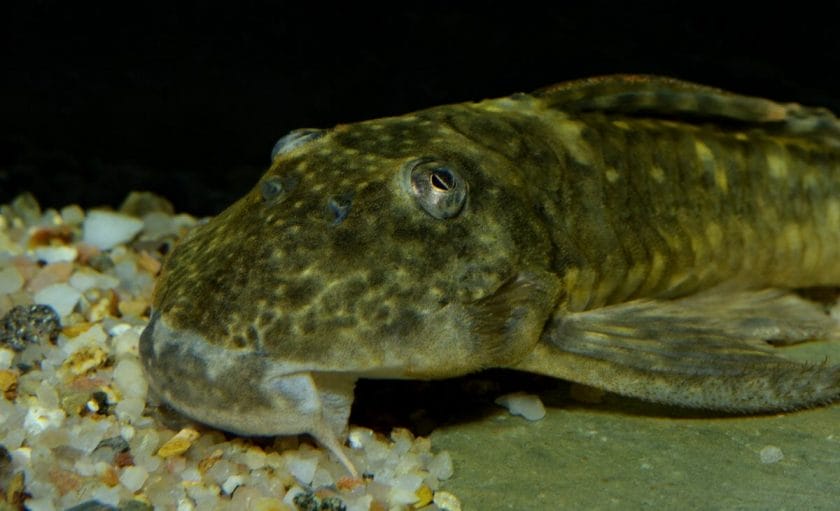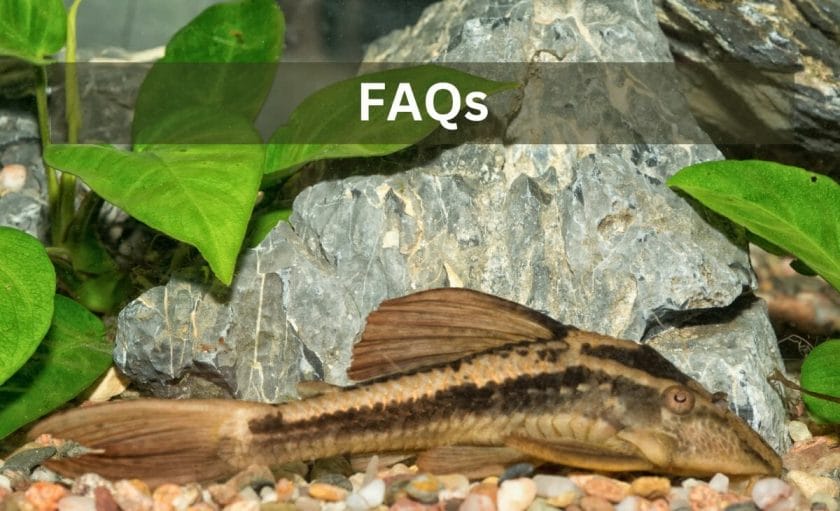Plecos are entertaining and can add a splash of color, intrigue, and personality to your tank; however, what most beginners don’t realize is that the size of your tank is extremely important to helping your plecos (and your tank as a whole) thrive.
Most pleco species that only grow to be a few inches in length need at least 30 gallons of space to properly grow and develop. Other species, like the Common Plecostomus that grow up to 2 feet, need well over 100 gallons of space.
Knowing how to accommodate your plecos with the appropriate amount of space is important for chemical, hormonal, and ethical reasons.
Keep reading so that you can learn some of the most important things to remember with regard to plecos and tank size.

Table of Contents
What’s the Ideal Tank Size for Different Species of Plecos

Plecos are one of the most overstocked fish in the freshwater aquarium community, mostly because people don’t realize how big they get and how hefty their bioload can be. Some species of pleco, for example, grow upwards of 2 feet long. In general, a fish that big needs at least a 100-gallon tank to thrive.
In a similar vein, plecos contribute heavily to the bioload, which is a measure of the organic waste produced in the tank. Some fish are ‘messier’ than others with regard to bioload, and plecos, due to their size and nature, contribute heavily.
Of course, that doesn’t mean you can’t include plecos in your tank, but it does mean that you should put careful consideration to what fish you’re putting into a tank to make sure the beneficial bacteria in the filter media can keep up with the waste your fish are producing.
Here’s a breakdown of some of the most popular pleco species and the minimum size tank they can live in:
| Species | Minimum Tank Size |
| Gold Spot Dwarf Pleco | 10 gallons |
| Bristlenose Pleco | 20 gallons |
| Zebra Pleco | 20 gallons |
| Clown Pleco | 20 gallons |
| Leopard Frog Pleco | 30 gallons |
| Tiger Pleco | 40 gallons |
| Gold Nugget Pleco | 50 gallons |
| Common Pleco | 100 gallons |
| Sailfin Pleco | 100 gallons |
| Royal Pleco | 120 gallons |
| Adonis Pleco | 240 gallons |
Notice how some of these plecos require absolutely massive tanks to accommodate; moreover, these are on the lower end of the recommended spectrum for tank size.
In other words, if you want to put other fish in your tank, then you might want to consider increasing the size of your tank even more than these recommendations.
How Big Can Plecos Get?

Different species of plecos can grow to different sizes, as a result of genetics and breed. Understanding the difference between plecos that stay small and those that grow to a massive size is important.
Here’s a breakdown of the pleco species listed above and how big they get:
| Species | Size |
| Gold Spot Dwarf Pleco | 2 inches |
| Bristlenose Pleco | 3-5 inches |
| Zebra Pleco | 3-4 inches |
| Clown Pleco | 3-3.5 inches |
| Leopard Frog Pleco | 3.5-4 inches |
| Tiger Pleco | 5-6 inches |
| Gold Nugget Pleco | 7-10 inches |
| Common Pleco | 15-24 inches |
| Sailfin Pleco | 13-19 inches |
| Royal Pleco | 15-17 inches |
| Adonis Pleco | 35-40 inches |
As you’re probably starting to realize, the bigger a fish is, the more impact it has on the waste that the filter media must cycle through. A tank that is not adequately sized to handle the waste a fish produces will suffer from a buildup of harmful ammonia, among other problems.
For the most part, it’s simple to understand what you’re getting in a pleco by doing a little research, but there is a particular species that deserves a little more attention.
Some Love for the Common Plecostomus

Most species of ‘big’ pleco are well recognized. No one is going to sell you an adonis pleco without making sure you understand just how big the catfish can get. The common pleco, on the other hand, is one of the most mistreated fish species in the world, simply because many pet stores will not inform you just how big they get.
From the charts above, you’ll recognize that common plecos grow up to 2 feet and need at least 100 gallons of proverbial leg room to be happy.
Most aquarists buy this species of pleco in ignorance when they’re 1-2 inches long, not realizing that they’ll one day have a 2-foot behemoth on their hands. That’s why you’ll often see neglected plecos in lakes and ponds because owners will dump them upon realizing that their 10 gallon community tank just isn’t going to cut it.
The internet is unhelpful on this matter, too, since searching “common pleco tank size” will tell you that 30 gallons is plenty. This information does not regard the species Hypostomus Plecostomus, but rather ‘common’ pleco species in general. The common pleco needs at least 75 to 80 gallons to live but prefers up to 150 gallons to thrive.
Why Is Tank Size Important for Plecos?

Let’s discuss why all of this information is important. What happens when a fish—not just a plecostomus—is put in a tank that’s too small for them?
The main detriment to fish is as a result of ammonia. Organic waste naturally produces ammonia, something that, in a healthy tank, is converted into nitrites, then nitrates, which are much more manageable. A buildup of ammonia quite literally burns the skin and gills of the fish, causing them considerable pain.
This is a major issue for many species of fish, but it’s best understood when you think of a Betta Fish or a Goldfish inside a tiny bowl. Because the bacteria in the water cannot support the bioload of such a relatively large animal, the fish is consigned to suffer in a small space in toxic water.
The same principle is true for plecos who are placed in tanks that are too small, although it’s rarely intentional malice that harms them; instead, aquarists simply fill the tank with too many fish or don’t do their research to discover just how big different species of fish can get.
Cleaner Fish: Fact or Fiction?
Another aspect that makes tank size such an important consideration for plecos specifically is that many people tout them as cleaner fish that can keep your glass and plants clear of algae. Yes, many species of pleco do love algae as an essential, nutrient-rich part of their diet, but the term ‘cleaner fish’ probably doesn’t mean what you think it does.
In this case, plecos are only ‘cleaner fish’ in an aesthetic sense. They can keep algae off the glass; that’s about it. They cannot singlehandedly stop an algae bloom, especially if there are other conditions that are encouraging the growth of algae.
Stunting
Lastly, plecos suffer from stunting if not properly accommodated with the right tank size. Stunting is a general term for when an animal’s growth is inhibited by external factors in an abnormal way. This looks much the same in the water as it does outside of the water.
Through a complex biological process, a fish will stop growing upon recognizing that the tank environment they’re living in isn’t big enough to accommodate them at full size. Their organs, however, will not stop growing, potentially causing painful deformities and abnormalities that will affect them for the rest of their life.
These sorts of biological issues are prevalent in many species of fish, not just plecos, so it’s certainly worth making sure you choose fish that are catered to the tank size you have rather than picking without considering their eventual size.
In most cases, the more common aesthetic species of pleco only need 30 gallons to thrive, but you should always do your research to identify what species of pleco you’re thinking of buying and how big they get.
Exercise special caution in pet stores and specialty fish shops. There are undoubtedly some fishkeepers that love what they do and will be more than happy to help point you in the right direction.
Others, however, don’t have a clue what they’re talking about (sorry PetSmart) and will give you wrong instructions. The last thing you want is a stunted fish; it’s unpleasant for you to watch and horrible for them to experience, so make sure to do your due diligence beforehand.
Should I Get a Big Tank for Plecos as a Beginner?

Another useful topic with regard to pleco species is size. If you’re wanting to house some of the bigger species of plecos in a larger tank, then you may be facing some additional challenges.
Of course, I commend your enthusiasm, and there’s nothing wrong at all with a beginner opting for a bigger tank. A larger tank size does, however, come with an increased level of difficulty in several regards.
Input Cost
Obviously, a bigger tank is going to cost you more to set up, especially when it comes to heating and filtration. With any type of aquarium hobby, it’s important to consider the cost of the setup and maintenance before diving in head first so that you don’t purchase something that isn’t financially sustainable.
Quarantining
The more fish you have in a tank, the more likely diseases and parasites can ravage your aquarium. Odds are that if you have a bigger tank, you have more fish in it. It’s important to follow through with the quarantining process for 4-6 weeks before introducing new fish or plants to a larger tank. The same general idea holds true for smaller tanks, but just be aware that you undertake more risk in a larger tank.
Oxygenation
Oxygenation is important for any size tank, but getting enough airflow in a bigger tank can be more challenging. You need to ensure your air pump is up to the task; ideally, you’d also include lots of plants in a bigger tank to provide hiding places for your fish and plenty of oxygenation.
Plants also compete with algae for resources, helping to keep their numbers under control.
Surface Movement
In a similar vein, you need to make sure your filter and air pump create enough surface movement so that the tank doesn’t stagnate. In a smaller tank, the difficulty is often not creating too much water flow such that the fish are uncomfortable. In a larger tank, balancing the ideal water flow to prevent stagnation is important to avoid algae blooms.
Stocking
Back to the heart of the matter, stocking becomes much more of a challenge to sort out in a larger tank. You need to balance aggressive fish with passive fish, make sure school sizes are adequate, and generally consider how all of your fish will get along on the top, middle, and bottom of your tank.
The same concerns hold true for smaller tanks, of course, but not necessarily to the same degree. In all honesty, aquarists who purchase big tanks are often after that ‘one’ fish that makes a gorgeous centerpiece and focus their other choices around ideal companions.
As such, if you want a larger tank, consider how you stock it carefully and be sure to test often to make sure the filter media is keeping up with the bioload.
Stand Size
A relatively simple concern, but an important one, nonetheless. Larger tanks can be extraordinarily heavy when filled with water, which means you need to purchase and set up a tank stand properly to accommodate it. You’ll also need to make sure the tank is level, 100% free of cracks, and rated appropriately for the size of your tank.
With smaller tanks, you can often get away with putting them on a countertop or a desk rather than taking up a significant amount of space on the floor.
Of course, none of these concerns should deter you from getting a bigger tank if that’s what you want to start out with, but personally, I recommend that you start with a smaller tank to get a feel for the maintenance and setup that’s involved. If you have your eye on a particular fish (maybe big pleco) that needs a bigger tank or just want to make the aquarium a centerpiece in your home, then go for it!
FAQs

Do Plecos Grow to the Size of the Tank?
Plecos, contrary to popular belief, do not grow to fit the size of the tank. Their growth may be stunted by a tank that’s too small, limiting the amount they can grow. In any regard, most plecos end up falling between a certain size range dependent on their species.
What Are the Best Small Plecos?
Some of the best small plecos I would recommend for a beginner include the Bristlenose Pleco, Clown Pleco, Zebra Pleco, and Gold Spot Dwarf Pleco. It’s a great way to introduce some color into your tank, and these species don’t need more than 30 gallons of space.
Can Plecos Live in a 10 Gallon Tank?
Plecos cannot feasibly live in a 10-gallon tank. While they may appear to be fine to the naked eye, most species of plecos will stunt in a 10 gallon tank because they don’t have enough room to grow.
Can you Put a Pleco in a 5 Gallon Tank?
You should never put a pleco in a 5 gallon tank, either short-term or long-term. It’s far too small for their needs and will cause stunting and severe ammonia burns. Fish exposed to toxic conditions for too long will also tend to jump, creating a hazard of asphyxiation outside the water.
Conclusion
Plecos are among the most mistreated fish in the aquarium hobby, and unfortunately, it’s down to uninformed beginners underestimating how big some species of plecos can get.
Preparing your tank adequately for your species of pleco can ensure it lives a long and happy life.
Make sure you pay attention to the helpful table and growth information about plecos above so that you can choose a species that’s right for you!